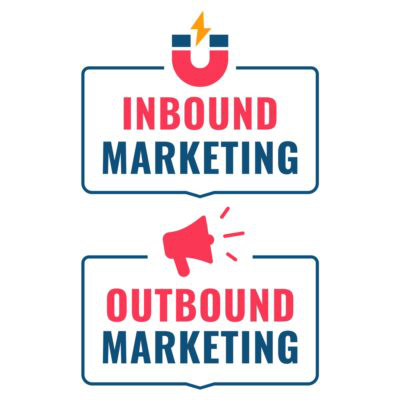If you’re a business owner, you want to make the most of your advertising budget.
And as you’ve searched for ways to optimize that spend, you’ve likely come across both inbound and outbound marketing strategies and wondered which is right for your company.
While they might seem similar, these two strategies don’t have as much in common as you might think. And choosing the right one is essential to your success.
Did you know the average American is exposed to between 4,000 and 10,000 advertisements every day? These ads reach people through outbound tactics—and many consumers go out of their way to avoid or ignore them altogether.
With ad blockers, consumers can ignore or remove these ads from their browsers entirely. But no such defense is needed against inbound marketing, largely because it’s information they want to read.
Inbound marketing uses consumer searches and valuable content to attract traffic to your site. Once you have their attention, you can then work to convert these readers into customers.
The best part? Because they were pulled to your site with inbound marketing, your readers will be paying attention and ready to interact with your brand.
What is Inbound Marketing?
Inbound marketing is your long-term marketing option. It’s the passive route that attracts interested readers (your prospects) to your site.
These readers are actively looking for solutions online. And when they find your content, they discover the guidance and help they were searching for.
This creates brand loyalty, increases your reach and gets readers closer to your sales funnel.
At the heart of all inbound marketing is valuable content, such as:
- Blogs
- Downloadable content (i.e., white papers, guides, eBooks)
- Website pages
This content provides a digital infrastructure that will serve your company for years. This is achieved by optimizing each piece you create for search engines using SEO services.
In exchange for producing and curating new high-quality content, you’ll receive organic leads from audiences who are engaged by what you say. And each of your readers becomes a prospective customer.
To get more readers, you’ll need strong brand visibility, authority and awareness, staying power achieved through strict adherence to SEO best practices.
Where Does Your Audience Come From?
Readers look for content for three basic reasons, each representing a different stage in the buyer’s journey:
- Researching a problem to find potential solutions
- Comparing potential solutions to a problem
- Performing due diligence before completing the transaction
Inbound marketing involves creating useful content that delivers results at each stop of the journey. In this way, it acts as a magnet, pulling the right people to your website instead of using generalized, more aggressive push marketing.
Think about it. When you need to solve a problem, what do you do? If you’re like most people, you grab your phone or open your laptop and head to Google. You then look at the top results, compare your options and use the best pages to find your best solutions.
After you’ve found potential solutions, you compare them and then do some final research before making a final decision.
Each step is represented in the three primary reasons readers look for content online.
How Does Inbound Marketing Convert?
Inbound marketing produces conversions by leading your audience down the sales funnel. First, they’ll look for the solution to their problem—the product or service you offer—and open links, including yours.
After deciding that your brand is one of the best they’ve found, they read the content you’ve provided. Once complete, they might follow a prompt to provide their email address for more free content.
Now you have their email address, and they have agreed to your company’s terms. You’re able to send additional offers to draw them further into your sales funnel. They then begin engaging with your company because they appreciate the useful content you provide.
Before you know it, you’ve captured your audience and are closer than ever to turning prospects into paying customers. And they came to you!
What Are the Costs of Inbound Marketing?
Inbound marketing costs less per lead than outbound marketing simply because it’s targeted. Each person who sees your content has a higher chance of becoming a solid lead because they’re more engaged throughout the process.
There’s no set cost for an inbound marketing program. It depends on what you need. Some of the many factors include:
- Planning and strategy
- Content production
- SEO services
- PPC management
- Social media marketing
- Platforms
- Lead generation and nurturing
Instead of sorting through numbers and calculating what each factor costs, make your job easier by contacting an agency directly. Every plan will be different. This is because companies that offer SEO services, content production and other digital marketing solutions typically charge different amounts for different needs.
On average, inbound marketing techniques cost a whopping 62% less than those involved in outbound marketing.
Additionally, it’s important to consider that:
- 60% of marketers create one or more pieces of content each day.
- 78% of CMOs believe that inbound content strategies represent the future of marketing.
- 89% of B2B marketers use content marketing.
What is Outbound Marketing?
Outbound marketing is your aggressive short-term option. Outbound solutions are designed to produce immediate results. Whether the results are good or not varies case-by-case.
The outbound approach is commonly known as push marketing or interruption marketing. The tactics center around getting a message out to as large of an audience as possible to make a sale.
Examples out outbound marketing include:
- TV/print/radio advertising
- Social media advertising
- Cold calling
- Email blasts
- Direct mail
It’s true that these traditional marketing efforts are designed for larger audiences. However, it’s likely that most of the intended audience won’t be interested in the marketer’s offering.
This is because people today like to get to know your brand before they make a purchase, a feature and consequence of the information age.
Where Does Your Audience Come From?
With outbound marketing, your audience comes from whichever medium you choose to use.
Let’s say you opt for social media. A Facebook campaign, to be specific.
You’ll set your audience parameters and create material designed to highlight your product or service. The message must be general, so it speaks to everyone, but also convincing. And it needs to intrigue people enough that they click through.
Once you’ve refined your ad and your audience, your campaign will show your message to people based on the categories you’ve selected.
Until your money runs out, your ad(s) will continue to display as people scroll through their Facebook feeds. With luck, some will click through to your page, and a few may even stay and engage with your message.
How Does Outbound Marketing Convert?
With outbound marketing, the hope is that people who visit your website and comb through your content will find what they’re searching for – the info that addresses their pain points no matter where they’re at in the brand interaction funnel.
Once engagement begins, the goal is to compel further engagement, perhaps through an offer to sign up for a newsletter or contact a professional. Once you have their email address, your marketing team can reach out with further outbound materials or target your audience through other content.
What Are the Costs of Outbound Marketing?
You already know that outbound marketing costs 62% more than inbound marketing. The exact amount you spend depends on your marketing strategy, your industry and your budget.
If you use outbound marketing services combined with an inbound marketing plan, you can make the costs of outbound marketing a little more reasonable.
Still, the digital age is beginning to phase out push-marketing strategies. Look to yourself for proof of this. Have you ever:
- Unsubscribed from an email list you previously signed up for?
- Skipped a television ad?
- Skipped a YouTube ad?
- Subscribed to an ad-free music provider (i.e., Spotify, Pandora, Google Play)?
- Found an email that went directly to your spam folder?
- Left a website because of annoying popups or intrusive ads?
These are everyday occurrences for many modern consumers, and they highlight one of the main issues with outbound marketing strategies.
Think back to our example of how inbound marketing converts. Remember that it’s your audience that’s coming to you. With outbound marketing, you’re putting targeted ads out, hoping to catch someone in the middle of their search for information.
When someone actively wants or needs your service, they’re much likelier to buy. But your ads will undoubtedly be seen by people who are not actively searching for what you offer—people who are less likely to click through or engage your company.
To make outbound marketing effective, you need to look at the following questions:
- How do we reach audiences who are actively engaged in the buyer’s journey?
- How do we turn these prospects into customers?
More often than not, the answer is inbound marketing. When combined with a quality inbound strategy, outbound marketing can still be highly effective.
What Type of Marketing Campaign Is Best for Your Company?

The best type of campaign for your business depends on your goals. For example, if you need:
- Immediate results, you’ll have a higher chance of quick results with outbound marketing. Examples might include social media campaigns, email blasts, and cold calling.
- Authority and long-term success, you’ll have a better chance with inbound marketing. Examples might include SEO services, content production, and social media engagement.
- Results both immediate and long-term, you might want to combine the two. Adding push marketing into the mix will make it more expensive, however.
Write down your company’s goals and price your options for each one. If you have a higher budget, you’ll likely want to implement both options to produce the most results. Companies with smaller budgets typically gravitate toward the stable, long-term results of inbound efforts.

